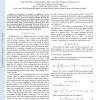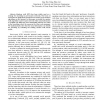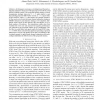ICC
2009
IEEE
15 years 7 months ago
2009
IEEE
Abstract—In this paper we propose non-regenerative multicarrier multiple-input multiple-output (MIMO) relay techniques that minimize the mean-squared error (MSE) of the signal wa...
ICC
2009
IEEE
15 years 7 months ago
2009
IEEE
— To ensure the security of sensitive Web content, an organization must use TLS and do so correctly. However, little is known about how TLS is actually used on the Web. In this w...
ICC
2009
IEEE
15 years 7 months ago
2009
IEEE
—A widespread methodology for performance analysis in the field of communication systems engineering is network simulation. While ns-2 has established itself as virtually the st...
120
click to vote
ICC
2009
IEEE
15 years 7 months ago
2009
IEEE
—Flash-crowd attacks are the most vicious form of distributed denial of service (DDoS). They flood the victim with service requests generated from numerous bots. Attack requests...
ICC
2009
IEEE
15 years 7 months ago
2009
IEEE
—In this paper, we present an application of the Extended Kalman Filter for the on-line estimation of a dynamical carrier phase offset. The novel approach implies deriving the �...
ICC
2009
IEEE
15 years 7 months ago
2009
IEEE
—Random walk (RW) has been widely used as a strategy for searching in peer-to-peer networks. The boom of social network applications introduces new impact to the classical algori...
131
click to vote
ICC
2009
IEEE
15 years 7 months ago
2009
IEEE
—Routing in ad-hoc networks can consume considerable amount of battery power. However, as the nodes in these networks have limited power, routing is very much energy-constrained....
ICC
2009
IEEE
15 years 7 months ago
2009
IEEE
—This paper proposes a method to improve the robustness of the carrier sense system for Opportunistic MAC (OMAC). This carrier sense method is specific for MIMO and the new vers...
102
click to vote
ICC
2009
IEEE
15 years 7 months ago
2009
IEEE
Abstract—In this paper, we propose a training-based channel estimation scheme for large non-orthogonal space-time block coded (STBC) MIMO systems. The proposed scheme employs a b...



